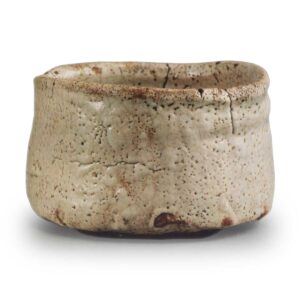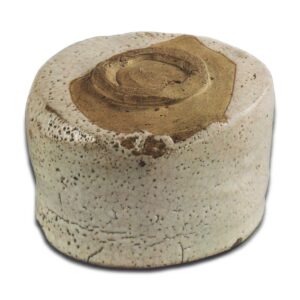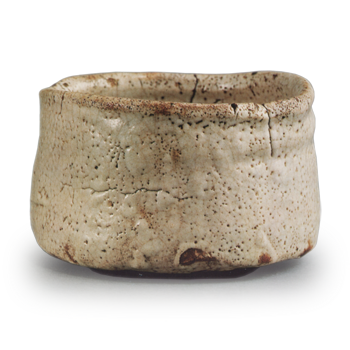

Height: 7.8 to 8.3 cm
Diameter: 11.5 to 13.0 cm
Foot diameter: 6.0 cm
Height: 0.5 cm
Shino ware with a plain white surface without iron designs is commonly referred to as “plain Shino”. Compared to decorated Shino and grey Shino, there are very few examples of plain Shino, and in particular, there are very few tea bowls. This tea bowl is particularly outstanding, but it has never been introduced before, perhaps because it was not well known.
The clay is a rough, eggshell-colored kaolin, and the snow-white Shino glaze is applied generously to the entire inside and outside of the cup. The glaze is white, but with a hint of grey, and is slightly reduced, but the rim and the areas with a thin glaze have a reddish tinge, and the overall color is warm. There are rough cracks all over the surface, but the thick parts of the glaze are particularly rough, while the thin parts are slightly finer.
The shape is a bulging, steep-sided form, but the waist is plump and round. The thick, bevelled rim has subtle variations, and when viewed from above, the mouth is not a perfect circle, but is slightly oval. The inside of the bowl is deeply indented with a strong tool, and there are no signs of other objects having been stacked on top and fired. The foot ring is roughly carved out with a wooden spatula, and the foot ring and surrounding area are exposed. The exposed area is slightly charred like a rice cracker, giving it a soft feel.
There are four finger marks where the glaze was applied, but they are not as clear as those on the Uka-bai. There is a hint of the color of the fire around the rim, but this is a piece of Shino with a low level of the color of the fire, and it seems that the color of the fire has faded due to over-firing. However, the low level of the color of the fire is not a fault of this tea bowl, but rather enhances its elegance.
The shape and workmanship are closer to Setoguro than Shino, and in that respect, this is a rare type of Shino tea bowl.
There is one gold-leaf decoration around the rim, and six “hito” (tubes) that are commonly referred to as “yama-kizu” (mountain scars).
It was probably made in Ogaya, Mino, sometime between the Tensho and Bunroku periods.
The inner box is a bentwood item with a cherry-blossom-patterned lacquer finish, and the lid is inscribed in red lacquer with the words “Shinou no hana” (Japanese bush clover), but it is also said to be a writing by Soan. The history of the box is not well known, in part because it was not known to the world in the past.



